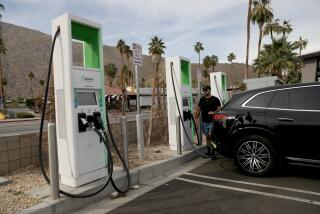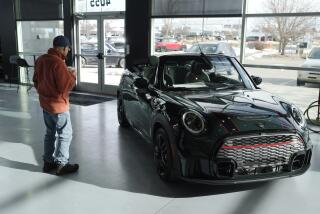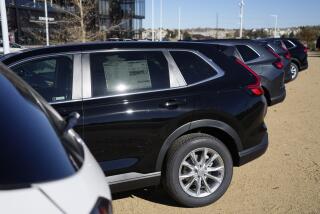COLUMN ONE : Car Buyers Signal for a U-Turn : As Japanese auto makers raise prices and consumer tastes shift, many U.S. motorists who swore they would never have another American-made model are starting to reconsider.
DETROIT â In 1988, having survived a 1979 Oldsmobile whose air conditioner wouldnât work and a 1986 Buick whose front-wheel-drive leaks cost thousands of dollars to fix, Jerry Koon, a Huntington Beach delivery van driver, vowed never to buy another American-made car.
He had plenty of company. Fed up with cars that guzzled gas, cost too much, broke down all the time and occasionally exploded on impact, one in four American car owners abandoned their Detroit iron in favor of Japanese vehicles over the last two decades.
As Japanese auto makersâ share of the U.S. vehicle market soared from less than 15% in 1978 to 25.7% in 1991, their incursion into Detroitâs turf seemed inexorable. But motorists who swore they wouldnât be caught dead in a Chevy, Ford or Chrysler are now going back on their word.
Koon, 50, bought a Ford Explorer last month after admiring the one in his neighborâs driveway and figuring out that the Nissan Pathfinder would cost him more than $700 extra.
âI said Iâd never do it,â Koon says. âBut then Ford makes this car thatâs good-looking and easy to drive, and they priced it right, so what the heck? It gets decent gas mileage too.â
Higher prices on Japanese vehicles, a surge in the Detroit-dominated minivan and sport utility markets and a rise in patriotic consumerism have persuaded Americans to take a look at U.S.-built cars and trucks once again. And after they have looked, many of them have been persuaded to buy by the U.S. industryâs strides in quality over the last five years.
U.S. auto manufacturers have captured 72.5% of the vehicle market through the first half of this year. That is up 1.6 percentage points from last year--a swing of about 100,000 vehicles--while Japanese market share has receded 1.4 percentage points to 23.9%.
Fordâs redesigned Taurus has a good shot at dislodging the Honda Accord as the top-selling car model in the United States. Half of General Motors Corp.âs Saturn customers say they would have bought an import as their second choice. And Chrysler Corp. is leading a sharp rise in the minivan market, of which Big Three sales account for more than 90%.
Even in California, where half of all the cars sold are foreign and driving an American model has long been considered socially backward, there are signs of change. Some Californians--always on the lookout for something different--may even be poised to rehabilitate Detroit as the next automotive fashion trend.
âPeople seem to really look at me when Iâm driving it,â Koon says of his new sport utility. âAnd the guys at work were all jazzed. They were like, âWow, you bought a Ford!â â
To be sure, there is a large and less forgiving faction of American consumers that Detroit has likely alienated forever. And the Japanese are not likely to cede any portion of their share to the Big Three without a fight.
But faced with financial problems at home and protectionism abroad, the Japanese may be forced to ease up on Detroit for a time. And if the beleaguered American automotive industry can restrain itself from raising prices and falling asleep at the wheel as it has in the past, analysts say, it has a chance to win back customers and attract a generation of new ones.
Reversal of Trend
âIt would be premature to conclude that Japanese share growth has been permanently reversed,â observes Maryann Keller, a leading auto industry analyst and managing director of Furman Selz in New York. But the 1992 selling year will âdefinitely mark a reversal of a long-term trend.â
Detroitâs uptick dates from the aftermath of the Gulf War, when the Big Three sought to capitalize on a wave of patriotic sentiment. The flag-waving sales pitch got a boost last winter when a Japanese official called American workers lazy and dumb and GM announced the elimination of 74,000 U.S. jobs and the closing of 21 plants.
Dealers, auto suppliers and several firms that bore no relation to the automotive industry tried everything from selling bumper stickers (âTired? Hungry? Out of work? Why donât you eat your import?â) to offering employees cash toward an American-made vehicle.
And despite a prodigious counter-propaganda campaign by Japanese auto makers, who manufacture more than a million vehicles in the United States each year, dealers say the Buy American movement succeeded in getting people to at least stop in to domestic showrooms to see what they have to offer.
Effect on Economy
For Linda Liberty of Torrance, however, it was less patriotic inspiration than harsh economic reality that influenced her recent purchase of a Ford Thunderbird. Although she seriously considered a Honda--her brotherâs had gone 200,000 miles with no problems--the sight of her husbandâs McDonnell Douglas colleagues getting laid off made her decision for her.
âI really wanted to buy an American car,â she said. âNot that one car would make a difference in the economy--but if everyone thought that way, it might.â
Dealers say people are thinking that way more than might be expected, especially in California. As the stateâs recession has dragged on and unemployment has climbed, car buyers have increasingly considered the impact of their buying behavior on the regional economy.
âI canât tell you how many people have said to me lately, âThis is the first American car Iâve bought in 10 years,â â says Joe Laskowski, sales manager at Hansel Ford in Santa Rosa, Calif. âOr they come with a Japanese trade-in and they say, âItâs been a good car but I always feel guilty driving it.â â
John Campbell, president of the Campbell Automotive Group, who runs five auto franchises in the Los Angeles area, including Nissan and Mazda, attributes the higher sales rate at his three domestic dealerships largely to the Buy American movement.
âWith all the layoffs going on here, the Buy American fever is setting in more in California than it ever has in the past.â Campbell says. âI think the import penetration has maxed out in Southern California. The pendulum is going to shift the other way.â
But as Japanese auto makers expand their production in the United States, Detroit may not be the sole beneficiary of consumer choices aimed at bolstering the economy. Les Williams and his friend set out at the same time to buy an American car. Williams traded in his 1988 Acura Legend for a Saturn. His friend bought a Mazda MX-6, built at the Japanese auto makerâs assembly plant in Flat Rock, Mich.
âThat was what was important to him--that it was built in America,â Williams says.
And although guilt, patriotic verve or genuine desire to help stimulate the economy may draw customers to domestic showrooms, market analysts say price and quality are what persuade them to buy.
The quality of domestic cars has improved 20% over the last five years, according to surveys by Agoura Hills-based J. D. Power & Associates of customer-reported problems in the first 90 days of ownership. But Detroit still lags behind its Asian competitors, racking up 136 problems for every 100 cars in the 1992 model year compared to 105 problems per 100 cars for Asian brands.
Still, J. D. Powerâs John Hammond says, the overall improvement in domestic and Japanese quality may make it nearly impossible to distinguish between the two. And the combination of higher domestic quality with lower pricing may be enough to win over consumers in the middle.
It was enough for Virginia MacBride, who was about to give up on the Buick Century wagon she had been loyal to for years after the endless problems sheâd had with it.
âIt would all of a sudden sound like a motorcycle,â said MacBride, a professor at a Los Angeles area community college. âIt would not ride level; it would torque to one side--I had nothing but trouble.â
But when the car was rear-ended earlier this month, MacBrideâs dealership persuaded her to give Buick one last chance. âTheyâve done 180 degrees in terms of quality,â says MacBride, who ended up purchasing a 1992 model with the insurance money. âItâs a huge difference.â
âCrossovers,â as J. D. Power refers to people who switch from foreign to domestic brands, are harder to please. Market studies have shown that they are likely to expect more from their domestic vehicle and therefore be more critical and less loyal.
âMore for the Dollarâ
Pamela Tuli, for example, a Hughes Aircraft engineer who recently traded in her Jaguar for a Cadillac Seville despite her friendsâ urgings that she buy a Lexus, is not exactly effusive about her new luxury car.
âThe steering is a little loose. Iâm not as confident on the curves as I was in the Jag,â Tuli says. And sheâs had some problems with the driverâs-side seat belt.
But Tuli, 47, is also one of a growing segment of American consumers for whom a âsmart buyâ may be more important than perfection in quality and performance. Tuli says: âI liked the BMW, but it was âspendy.â I felt the Cadillac had more for the dollar.â
Conspicuous displays of wealth are no longer in vogue in the recessionary 1990s, and the BMW--and the 1980s excesses it connotes--is no longer the status car of choice. That means yuppies, that much-coveted demographic group, are considering the less expensive, more understated American car far more seriously than they have in the past.
âBuying smart now brings with it the kind of status that buying expensive brought with it 10 years ago,â Hammond says. âItâs a long-term, fundamental social trend that extends into car purchases.â
Michael Marsden, who teaches a course called the Automobile in American Culture at the University of Kentucky, says this shift in American cultural values is helping to bolster Detroitâs comeback.
âThereâs a resurgence of faith in the American ethos,â Marsden says. âItâs becoming, in a sense, chic to be driving American again.â
To some extent, Marsden said, Americans are simply getting bored with their foreign-made vehicles. Japanese cars have become so ubiquitous--especially in California--that they no longer distinguish their owners from everyone else.
âIf everyone has one, how does it make you different?â Marsden says. âNow the Saturn, for example, is a hell of a conversation starter. Someone drives up to a party in a Saturn, they talk about it for hours. And that social currency is a big factor. We should never underestimate the social factor in buying a car.â
The Talk of the Block
Thatâs something Michelle Majewski of Rancho Santa Margarita can identify with. When she set out two weeks ago to buy a Mazda MX-6, she came back with a Saturn and immediately became the talk of her block.
âI got a lot of comments as far as âgood move, Michelle, you bought American.â Three of my neighbors stopped when they saw it in the driveway, and one of them went and bought one themselves.â
The Big Three have initiated a host of new marketing schemes aimed at exploiting these shifting cultural winds, from non-negotiable sticker prices to extensive dealer training programs.
But cultural fashion trends can only take the Big Three so far. When it comes down to deciding what to buy, analysts say, price is the deciding factor. And Japanese brand cars are losing much of their former price advantage.
An analysis by the University of Michigan Transportation Research Institute that compared 1991 model year list prices of cars by market segment found that Japanese-badged cars had a price advantage in only one of nine categories. In the small car segment, for example, which includes the Ford Escort and the Subaru Justy, Japanese cars were found to cost an average of $284 more than those sold by the Big Three.
Price clinched it for Misty Terrance, 19, who--in a reversal of a generational trend that is exactly what Detroit wants to see--traded in the 1986 Honda Civic her parents had given her for a new Ford Escort earlier this month. Although she wanted to buy an American car, she would have considered anything if the price was right.
âThe Escort was one of the only things I could afford,â says Terrance, who works part time as a secretary and attends school at Fullerton College. âI like it. It has more pickup speed, and itâs smoother.â
Strategy on Price
At a time when Japanese auto makers are raising prices in the United States in response to recession and higher cost of capital in their home market, analysts say the Big Three stand to benefit from Americaâs newfound frugality--if they keep prices down.
To snare consumers who have had bad experiences with domestic cars in the past, analyst Keller says, âWhat (Detroit) needs is for any residual fear to be overcome in the price.â
Provided with similar openings in the past, the domestic auto makers have simply raised prices along with their competition. And there are already signs that after a year of record losses, the temptation to do so again is hard to resist.
Ford last week raised 1993 prices 3% to 6%, while Chrysler announced pricing for its new mid-size sedans that tops much of its competition. Japanese auto makers hiked their U.S. prices an average of 5% earlier this year, and will likely push them up further for the 1993 model year. But the recent pricing moves by Detroit were greeted with groans from most industry observers.
The Ford price increase âwas double what I thought it should have been,â says auto analyst Susan Jacobs of Little Falls, N. J.-based Jacobs Automotive, a research and forecasting firm. The Chrysler LH pricing âwas also too high. You have to build your image as a good value versus the Japanese over a two- to three-year period so you gain credibility. The fact of the matter is (Chrysler) doesnât have the credibility.â
Other than price, the main thing the Big Three have going for them is the growing popularity of minivans and sport utility vehicles--classified as trucks--which are segments of the market that domestic manufacturers invented and still dominate. Truck sales, up 12.1% over last year, are leading the auto industry recovery, while car sales through June have improved only 1.6% over the 1991 period.
Although the U.S. auto makers have hung on to just 65% of the U.S. car market, they maintain an 85% share of the U.S. truck market. And trucks now account for 35% of the U.S. vehicle market, up from 25% a decade ago. Minivans alone now total 7.4% of the U.S. market, and sport utilities are up to 7.1% from 3.6% in 1986.
Now Detroit is launching critical new cars as well, taking on Japan in the family-car market. But it had better move quickly.
Indeed, the breathing room Detroit has now is largely a result of various forms of political pressures that will likely ease as the economy begins to pick up and the election year draws to a close. Keller, just returned from Japan, warns that the resourceful Japanese auto firms have impressive plans of their own.
And Detroit might never persuade countless motorists like Frances Gonzalez, who has been stranded on the freeway more times than she cares to remember by her 1987 Oldsmobile Cutlass Calais. She says she will never give Detroit another chance.
âI had a Toyota and then a Subaru, and then I thought, âOh, well, letâs help the economy by buying American,â â Gonzalez snorts. âFrom day one, it gave me problems.â
Gonzalez plans to stick with her Honda Accord.
Detroitâs Driving Force
Price, quality and a strong Buy American campaign are helping the Big Three U.S. auto makers drive into territory once thought under the permanent ownership of the Japanese. The changing market share for U.S. cars and trucks:
Big Three Japan 1988 74.2% 20.0% 1989 73.5% 21.9% 1990 71.6% 24.0% 1991 70.5% 25.7% 1992* 72.5% 23.9%
*Through June






